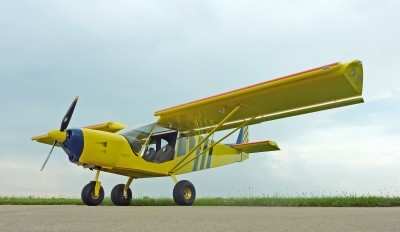Aircraft Gross Weight Bumped 120 Pounds
Zenith Aircraft Company has announced a design gross weight
increase for the STOL CH 750 aircraft design. The aircraft design
gross weight has been increased from 1,320 lbs. to 1,440 lbs., an
increase of 120 lbs. The increase adds significantly to the load
carrying capability of the “light sport utility”
aircraft first introduced at AirVenture (Oshkosh) in July 2008. The
gross weight increase applies without airframe modifications to all
aircraft built to drawings Edition 2 (drawings, dated July 20,
2010), and operated as “Amateur-built –
Experimental” aircraft. STOL CH 750 aircraft registered as
SLSA and/or operated by Sport Pilots are not affected as the weight
limit per FAA rules for Light Sport Aircraft (LSA) continues to be
1,320 lbs.

Zenith STOL CH750
Several rigorous static load tests were performed on the
structure in preparation of this gross weight increase. Aircraft
built to Edition 2 drawings incorporate structural changes to
justify the extra load, especially to accommodate larger (up to
160-hp) and heavier (up to 280 lbs. installed weight) engines.
“We have not changed the basic design, since the CH 750
offers such great performance, capabilities and features,”
stated Zenith Aircraft Co. president Sebastien Heintz. “With
the Edition 2 drawings we have increased the capabilities of the
aircraft, especially for pilots using the aircraft as a utility
plane and to allow for additional larger engines, such as
Lycoming’s new 233 powerplant.
Sport Pilots [in the United States]will continue to be limited
to the 1,320 lbs. gross weight, but with the added peace of mind
that the additional margins provide, and private pilots can take
full advantage of the added useful load now available for the STOL
CH 750 registered as a Amateur-Built Experimental (EAB)
aircraft.”
The STOL CH 750 is an all-metal short take-off and landing
(STOL) kit aircraft designed by veteran aeronautical engineer Chris
Heintz. As a utility STOL design, the aircraft features a very
rugged landing gear with oversized tires for rough field
capability, yet uses a tricycle gear configuration (with steerable
nosewheel) to make it easy to fly (and taxi) even for low time
sport pilots. The high-lift wing features fixed leading edge wing
slats for maximum lift and full-length “Junker”-type
flaperons (both ailerons and flaps) for outstanding slow flight
handling characteristics. The high tail design utilizes an
all-flying rudder and a unique inverted horizontal tail (equipped
with micro vortex generators) to help the airplane achieve steep
approaches and short landings. The aircraft features standard
“bubble doors” to maximize both visibility and cabin
width, and is available as a complete kit, with modern features
such as match-drilled pilot-hole parts and components for ease and
simplicity of construction. Powered with the air-cooled
six-cylinder Jabiru 3300 engine (105-hp @ 2,950 rpm) the STOL CH
750 has a take off roll of just 100 feet and climbs at 1,000 fpm
with two .. Gross Weight Increase for STOL CH 750 Light Sport
Utility Kit Plane on board. Stall speed is just 35 mph, and cruise
is 100 mph, an impressive figure for such a high-lift design.

Today, nearly 500 STOL CH 750 aircraft are under various stages
of construction, with several dozen aircraft already flying around
the United States and around the world. The popular aircraft can be
built from the complete kit, component
“buy-as-you-build” kits, or scratch-built from plans
only (blueprints).
For kit builders, a variety of different engine types can power
the STOL CH 750, especially with the new higher gross weight.
Current supported installations include the Jabiru 3300, the
Continental O-200 series (including the lightweight D model), the
Rotax 912S and 914 engines, and various auto conversions such as
Corvair, Honda and Subaru conversions.
New installations include the ULPower UL350i series, as well as
Lycoming’s new YO-233 LSA engine rated at 115 hp. Older
Lycoming models such as the O-235 and O-320 are also suitable for
installation (for a maximum installed weight of 280 lbs.) Sport
Pilots will want to keep their aircraft as light as possible (using
a lightweight powerplant) to maximize their payload while meeting
the gross weight requirement of the FAA rules.
 ANN's Daily Aero-Linx (05.06.25)
ANN's Daily Aero-Linx (05.06.25) ANN's Daily Aero-Term (05.06.25): Ultrahigh Frequency (UHF)
ANN's Daily Aero-Term (05.06.25): Ultrahigh Frequency (UHF) ANN FAQ: Q&A 101
ANN FAQ: Q&A 101 Classic Aero-TV: Virtual Reality Painting--PPG Leverages Technology for Training
Classic Aero-TV: Virtual Reality Painting--PPG Leverages Technology for Training Airborne 05.02.25: Joby Crewed Milestone, Diamond Club, Canadian Pilot Insurance
Airborne 05.02.25: Joby Crewed Milestone, Diamond Club, Canadian Pilot Insurance




